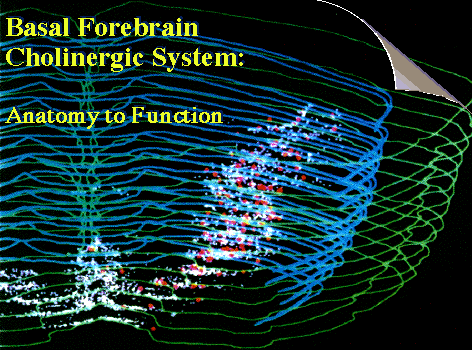
This database is under construction. However, your suggestions or questions are appreciated.
Email to:
zaborszky@axon.rutgers.edu or
zoltan@vis.caltech.edu

1.ANATOMY
1.1. Historical perspective of the BFC system
1.2. Basal forebrain organization
1.3. Brief survey of the cerebral cortex
1.4. Thalamus and Hypothalamus
1.5. Brainstem
6. Corticopetal systems
1.7. Distribution of BFC neurons
1.8. Efferent projection of BFC neurons
1.9. Pattern of cholinergic innervation in the target areas
1.10.Pattern of afferent terminals in the forebrain
1.11.Major afferent sources to BFC neuron
1.12.Transmitter-specific synapses on BFC neurons
1.13 Non-cholinergic neurons in the basal forebrain
1.14.Development of BFC and non-cholinergic neurons
1.15.Distribution of receptors in the basal forebrain
1.16 Input-output organization in the basal forebrain

2. REGULATION OF ACh RELEASE
2.1. Metabolism of ACh
2.2. Intrinsic membrane properties of BFC neurons
2.3. Electrophysiology of non-cholinergic neurons
2.4. Transynaptic regulation of ACh release in the cortex

3. POSTSYNAPTIC ACTION OF ACh
3.1.Postsynaptic cholinergic receptors
3.2.Modulation of postsynaptic cellular excitability by ACh

4. BEHAVIORAL AFFILIATION OF BFC NEURONS
4.1.Cholinergic involvement in cortical processing
4.2.Tonic activation of BFC neurons: Sleep-wakefulness
4.3.Phasic activation of BFC neurons: Motivation
4.4.Learning and memory
4.5.Computational models of ACh action

5.THE BASAL FOREBRAIN IN NEURODEGENERATIVE DISEASES

6.VULNERABILITY AND REPAIR OF BFC NEURONS

AROUSAL-SLEEP WAKEFULNESS
Lecture notes

7. DICTIONARY

8. REFERENCES

9. VRML LIBRARY
9.1. The VRML database of the BFC system
This site is designed by Zoltan Nadasdy
Qestions and comments to:
zoltan@vis.caltech.edu
Last updated: 01/06/1996
|
|
1.ANATOMY |
1.11.Major afferent sources to BFC neuron
1.12.Transmitter-specific synapses on BFC neurons
1.13 Non-cholinergic neurons in the basal forebrain
1.14.Development of BFC and non-cholinergic neurons
1.15.Distribution of receptors in the basal forebrain
1.16 Input-output organization in the basal forebrain
|
|
2. REGULATION OF ACh RELEASE |
2.1. Metabolism of ACh
2.2. Intrinsic membrane properties of BFC neurons
2.3. Electrophysiology of non-cholinergic neurons
2.4. Transynaptic regulation of ACh release in the cortex
|
|
3. POSTSYNAPTIC ACTION OF ACh |
3.1.Postsynaptic cholinergic receptors
3.2.Modulation of postsynaptic cellular excitability by ACh
|
|
4. BEHAVIORAL AFFILIATION OF BFC NEURONS |
4.1.Cholinergic involvement in cortical processing
4.2.Tonic activation of BFC neurons: Sleep-wakefulness
4.3.Phasic activation of BFC neurons: Motivation
4.4.Learning and memory
4.5.Computational models of ACh action
|
|
5.THE BASAL FOREBRAIN IN NEURODEGENERATIVE DISEASES |
|
|
6.VULNERABILITY AND REPAIR OF BFC NEURONS |
|
|
AROUSAL-SLEEP WAKEFULNESS |
Lecture notes
|
|
7. DICTIONARY |
|
|
8. REFERENCES |
|
|
9. VRML LIBRARY |
9.1. The VRML database of the BFC system
Qestions and comments to: zoltan@vis.caltech.edu
Last updated: 01/06/1996